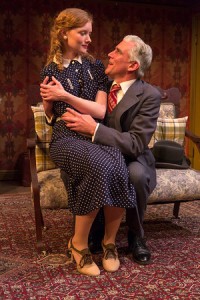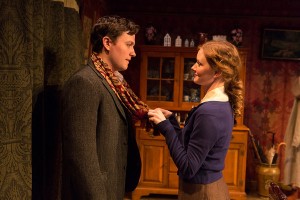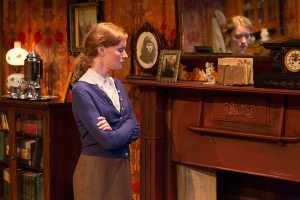THEATRE REVIEW: KATIE ROCHE
KATIE ROCHE
The Mint Theatre
New York City
Opened: 25 February 2013
Teresa Deevy, a little-known but well-regarded Irish playwright from the last century, penned a number of quietly affecting plays, the kind of forgotten dramas on which the Mint Theatre has made its name. Katie Roach is its third Deevy production. And typical of Mint shows, the acting is compelling, set design beautiful, and direction artful. Musical interludes of piano nocturnes by the Irish composer John Field are a delicate accent.
The three-act play, which opened on 25 February, is the playwright’s most frequently produced work. At its heart is Katie (Wren Schmidt), the striking lead whose youthful fervor, immaturity, and confusion collides with her staid, much older suitor Stanislaus Gregg (Patrick Fitzgerald).
When the play originally debut in Dublin’s Abbey Theatre in 1936, the Irish Independent newspaper called it a “Masterpiece.” Critics regarded Deevy’s dialogue as economical, modern before its time. She indeed approached this mark in previous Mint productions. Thus the bar is set very high for this subtle drama.
The actors are certainly up to the task. Schmidt’s seamless emotional range is made more radiant by Fitzgerald’s reserved portrayal of the older Gregg. But their characters don’t develop. Katie’s embryonic ambitions don’t take form. Stan remains Stan despite taking on a wife.
Marital strife is contrived through overreaction and mistaken intent rooted in mistrust. The playwright then avoids effectively dealing with these problems, restricting the play’s dramatic trajectory.
This is most evident in the way the drama winds up. Katie is forced by her husband to make a troublesome, life-changing decision without any say in the matter, only to find herself suddenly giving way to contentment as if struck by epiphany. This surreal happy ending may leave some in the audience wondering what just happened. But as director Jonathan Bank explains, Deevy rarely resolves conflict.
The production, instead, is like a painting in which actors flow through the single set—a warm country living room one would like to visit. In the middle, a frequently open front door frames a view of a lush floral landscape, set off beautifully by a backlit sky, and through which opportunities and troubles enter into Katie’s world.
The play is a brief montage of life without much explanation. It touches themes of male dominance and the irony of relationships. “If I were to lose my soul and body, that would be a bad thing…and how do I know would I have the grace to withstand you?” contemplates Katie in response to Gregg’s proposal. And after wedlock and a brief trip alone to Dublin, Stan admits “I’m fond of her, but the relief was amazing.”
This is potent stuff. But the story doesn’t seem to take us to where these words want to go.

Katie (Wrenn Schmidt)
and Stan (Patrick Fitzgerald)
There’s Deevy’s foray into religion. She suggests early on that God or doing good or saving one’s soul could be at the heart of Katie’s own ambitions, and then Deevy inserts a peripatetic preacher-like character with hidden links with the story’s protagonist. Again, the playwright never really goes anywhere with these ideas, instead treating them as flavor.
And then there is Katie’s younger would-be suitor, played affably by Michael Maguire (Jon Fletcher), who Katie jerks around throughout the story for no particular reason despite the young fellow being the most endearing of all on stage and her natural match. Again, an accent.
Does all this work?
Perhaps the potential and challenges facing the Mint’s handsome production were explained nearly 80 years ago by the original Irish Independent’s enthusiastic reviewer. In writing highly of the play, he added that he couldn’t “appreciate it fully at the moment (for it is) to be read, to be studied, to be seen again and again.”
This is very much the case. The simplicity that the play seems to be on first look evolves into something more subtle and expressive in subsequent viewing, as oft happens when returning repeatedly to works of art.


 GIR's Investing in the New Europe
GIR's Investing in the New Europe





